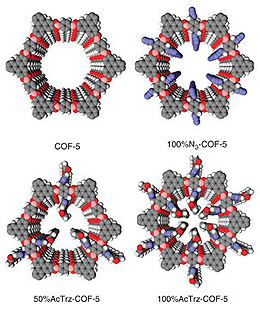Research Abstract
共有結合性有機骨格構造における多孔表面エンジニアリング
Pore surface engineering in covalent organic frameworks
2011年11月15日 Nature Communications 2 : 536 doi: 10.1038/ncomms1542

共有結合性有機骨格構造(COF)は重要な多孔性材料の1種であり、原子レベルで構成ブロックを精密的に組み立てることができ、あらかじめ設計された細孔サイズと形状を持つCOFを作製できる。しかし、COFにおける多孔表面エンジニアリングは依然として困難である。今回我々は、COF化学に多孔表面のエンジニアリングを取り入れ、有機グループを用いてCOF細孔壁を制御して機能化することを可能にしている。このような機能化は、アジドを有する構成ブロックを用い、設計した量のアジドユニットを細孔壁に固定したCOFを合成することによって可能になる。アジドユニットは、アルキンと定量的にクリック反応し、望みの官能基を望みの密度で導入した細孔表面を構築できる。さまざまなクリック反応が起こることから、この手法は、COFのさまざまな特殊表面の開発に適用できることが明らかである。したがって、今回の方法は、COFの多孔表面エンジニアリングにおいてあらかじめ設計した組成、成分、機能を実現するための一歩である。
- 自然科学研究機構 分子科学研究所
- 独立行政法人 科学技術振興機構 さきがけ
Covalent organic frameworks (COFs) are a class of important porous materials that allow atomically precise integration of building blocks to achieve pre-designable pore size and geometry; however, pore surface engineering in COFs remains challenging. Here we introduce pore surface engineering to COF chemistry, which allows the controlled functionalization of COF pore walls with organic groups. This functionalization is made possible by the use of azide-appended building blocks for the synthesis of COFs with walls to which a designable content of azide units is anchored. The azide units can then undergo a quantitative click reaction with alkynes to produce pore surfaces with desired groups and preferred densities. The diversity of click reactions performed shows that the protocol is compatible with the development of various specific surfaces in COFs. Therefore, this methodology constitutes a step in the pore surface engineering of COFs to realize pre-designed compositions, components and functions.

